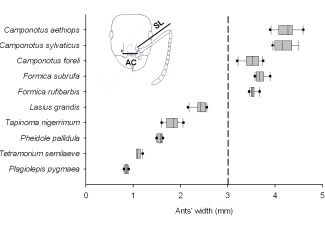Excluding ants from trees based on ant body size

The experimental exclusion has been used as a major tool to reveal species interactions in ecological communities. If one species is important for a concrete community, when excluded, the community’ structure changes. But if the community does not result disturbed, it means that this species does not significantly affect it.
In terrestrial ecosystems, the animals most frequently exclude are birds, reptiles and insects. Ant-exclusion experiments are the most numerous, as ants have a great number of interactions with animals and plants species. They are normally excluded from trees by placing sticky barriers or slippery substances on the trunk. These exclusion systems do not discriminate among ant-species but exclude them all. Occasionally, for some experiments it could be necessary to selectively exclude a group of ants rather than the entire ant community. Our study pretended to design a method to exclude only some ants’ species from tree canopies, based on ant body size.
The most common ant-exclusion system consists in a sticky barrier applied to plastic sheet tightly attached over padding cylinder in contact with the trunk. Our hypothesis was that if two plastic tubes of a certain diameter were placed underneath the padding cylinder, ants smaller than this diameter would use tubes as tunnels to access canopies, while larger ants would be left out of canopies. We studied our ant community in citrus trees and measured ant width of each species present. With this data, we decided to use tubs of 3 mm of internal diameter to allow access to canopies for Lasius grandis Forel and to exclude Formica sp. L. grandis is an important aphid-mutualist whose effectiveness is based on mass recruitment, whereas Formica sp. are also aphid-mutualists but they forage individually. L. grandis and Formica sp. are the dominant species in the community.
The results confirmed our hypothesis and all ant species smaller than 3 mm of width discovered the tubes and used them to access canopies while larger ants could not (see videoclip). Thus we had trees with Lasius grandis and without Formica sp. With this method, next year we will be able to study the differential effect of both ant species to aphids, and their differential direct or indirect effect to the plant itself. This simple method can be used by other researchers who have communities with ants of different sizes and functions.
References
"A simple method to differentially exclude ants from tree canopies based on ant body size". Romeu-Dalmau, C., Espadaler, X. & Piñol, J. Methods in Ecology and Evolution, 2010, 1, 188-191.


